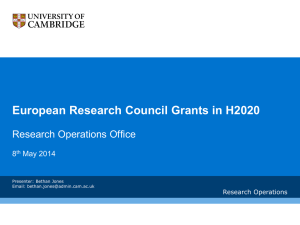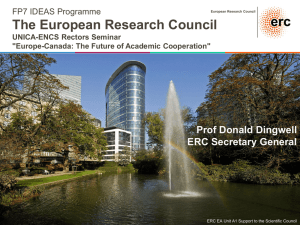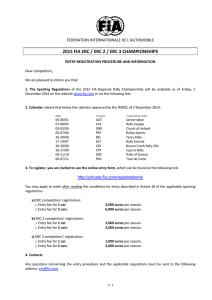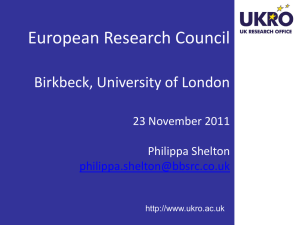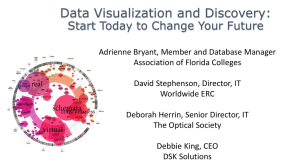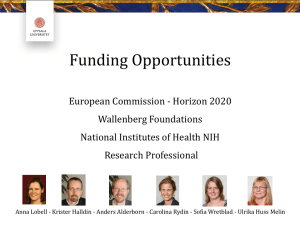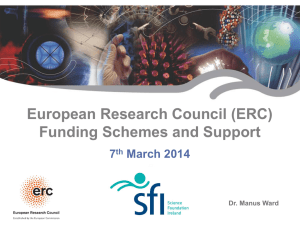European Research Council
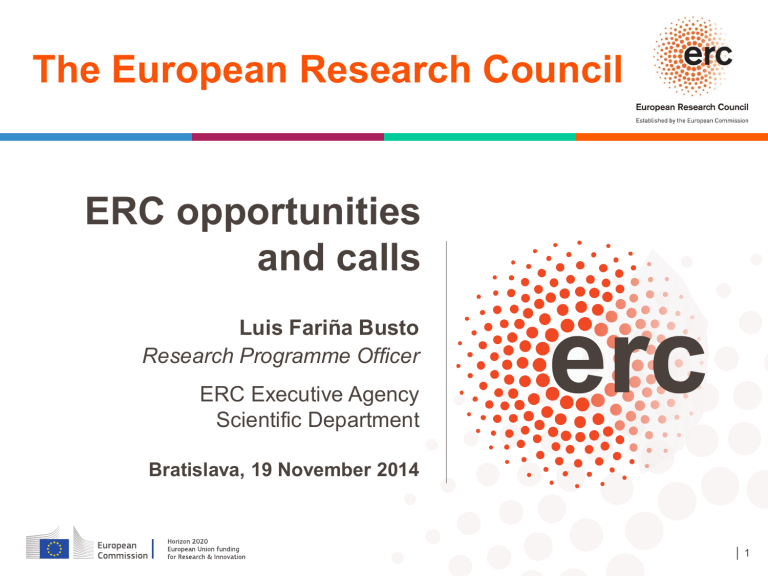
The European Research Council
ERC opportunities and calls
Luis Fariña Busto
Research Programme Officer
ERC Executive Agency
Scientific Department
Bratislava, 19 November 2014
│ 1
European Research Council http://erc.europa.eu
│ 2
European Research Council
promotes the best research in Europe
wants to bring the best international researches to Europe
promotes innovative and across-fields research
│ 3
Outline
Background
Evaluation Process
Preparing an application
Data
ERC-NSF
│ 4
What is the ERC?
Autonomous funding body set up by the EU in 2007 and led by scientists
1 researcher : Any nationality, age or current place of work in the world
No thematic priorities - All fields of science and humanities
No consortia, 1 Host Institution in Europe
Budget : € 13.1 billion (2014-2020) - 1.8 billion €/year
│ 5
2013-2020 : H2020 budget € 77 billion
ERC budget € 13.1 billion
│ 6
ERC grants in a nutshell
ERC awards are:
• Very competitive: ~ 10% success rates
• Significant: €1.5 Mio – €3.5 Mio
• Bottom-up: open to any topic
• Ambitious: achieve/boost independence; form a group
• Looking for High-risk/High-gain research
• Flexible: distribution of budget can be changed
• Portable: can be moved anywhere in Europe
│ 7
ERC – Basic elements of the grant
The Principal Investigator and the Research team
The PI can choose national or trans-national team members if scientific added value proven
The grant covers salaries (PI and team members)
Research project
High risk/high gain (Frontier research)
Up to 5 years projects
Host Institution
The one where the researcher already works, or any other institution established in the EU or associated countries
Universities, research centres; public or private
Grants are portable (the PI can change Host Institution)
│ 8
Attractive features for researchers from outside Europe
Incentive :
Additional “start-up” funding for scientists moving to Europe
(EUR 500 000 for Starting , EUR 750 000 for Consolidator , and EUR 1
Million for Advanced grantees)
Flexibility :
Grantee can keep affiliation with home institute outside Europe
(“significant part” of work time in Europe)
Team members can be based outside Europe
│ 9
After 7 years of existence…
more than 4000 proposals funded
highly competitive: average success rate 12%
EU value added: pan-European competition among researchers for the first time ever
making Europe more attractive in the global competition for scientific talent
│ 11
ERC Grant schemes
Starting Grants starters
(2-7 years after PhD) up to € 2.0 Mio for 5 years
Consolidator Grants consolidators
(7-12 years after PhD) up to € 2.75 Mio for 5 years
Advanced Grants track-record of significant research achievements in the last 10 years up to € 3.5 Mio for 5 years
Proof-of-Concept bridging gap between research - earliest stage of marketable innovation up to
€150,000 for ERC grant holders
│ 12
ERC Panel Structure
25 Panels
Each Panel : Panel Chair and 10-15 Panel Members
Life Sciences
LS1 Molecular & Structural Biology &
Biochemistry
LS2 Genetics, Genomics, Bioinformatics &
Systems Biology
LS3 Cellular and Developmental Biology
LS4 Physiology, Pathophysiology &
Endocrinology
LS5 Neurosciences & neural disorders
LS6 Immunity & infection
LS7 Diagnostic tools, therapies & public health
LS8 Evolutionary, population & environmental biology
LS9 Applied life sciences & biotechnology
Social Sciences and Humanities
SH1 Individuals, institutions & markets
SH2 Institutions, values, beliefs and behaviour
SH3 Environment ,space and population
SH4 The Human Mind and its complexity
SH5 Cultures & cultural production
SH6 The study of the human past
Physical Sciences & Engineering
PE1 Mathematics
PE2 Fundamental constituents of matter
PE3 Condensed matter physics
PE4 Physical & Analytical Chemical sciences
PE5 Materials & Synthesis
PE6 Computer science & informatics
PE7 Systems & communication engineering
PE8 Products & process engineering
PE9 Universe sciences
PE10 Earth system science │ 14
ERC Grants in
Social Sciences and Humanities
│ 15
Some ERC Grants in
Social Sciences and Humanities
SH1 Jean Tirole COGNITION
Cognition and Decision-Making: Laws, Norms and Contracts
SH2 Éva Pócs INTELEG Vernacular religion on the boundary of
Eastern and Western Christianity: continuity, changes and interactions
SH3 Wolfgang Lutz FutureSoc
Forecasting Societies’ Adaptive Capacities to Climate Change
SH4 Esperanza Alfonso INTELEG The Intellectual and Material Legacies of Late Medieval Sephardic Judaism: An Interdisciplinary Approach
SH5 Barbara Graziosi Living Poets
Living Poets: A New Approach to Ancient Poetry
SH6 Jean-Philippe Genet SAS
Signs and States: Semiotics of the Modern State
│ 16
Outline
Background
Evaluation Process
Preparing an application
Data
ERC-NSF
│ 17
Submission, evaluation and selection
Starting, Consolidator and Advanced Grants
Submission of full proposal (strict deadline!)
Eligibility check
(PI, HI, submission restrictions)
Step 1 (remote) evaluation on the basis of section 1 of proposal* by panel members
1st Panel meeting
Proposals passing to step 2
*) Profile of PI, project extended synopsis (Part B1)
Individual assessment of full proposal by panel members & referees
AdG:
2nd Panel meeting
StG, CoG:
2nd Panel meeting incl. interviews of applicants
Proposals selected for funding based on call budget
│ 18
Evaluation Criteria
Excellence as sole criterion, to apply to:
1.
Quality of the research project
Ground-breaking nature of the research: Important challenge?
Substantially beyond the current state of art? High-gain/high-risk balance
Potential impact: Possibility of a major break-through?
Scientific Approach: Feasibility, novel concepts/methodology
2.
Principal Investigator
Intellectual capacity and creativity: Track-record, capacity to go significantly beyond the state of the art, evidence of creative independent thinking
Commitment: Willing to devote a significant part of PI's working time
(minimum of 50% for Starting, minimum of 40% for Consolidator Grant, minimum of 30% for Advanced Grant)
│ 19
Who evaluates the proposals ?
• Panel members : typically 600 / call
USA
High-level scientists
Recruited by ScC from all over the world
(7%)
About 12 members plus a chair person
Other
(7%)
• Referees : typically 2000 / call
Evaluate only a small number of proposals
Similar to normal practise in peer-reviewed journals
│ 20
Outline
Background
Evaluation Process
Preparing an application
Data
ERC-NSF
│ 22
When to submit?
Increasing number applications causes low success rates and high panel workload
New Resubmission restrictions
•
Since 2014 calls, tighter resubmission rules : o
If B (Step 1 or Step 2) : will have to wait out one year o
If C (Step1) : will have to wait out two years
│ 23
Which Call?
StG/CoG : Possibility of eligibility extensions
Eligibility window can be extended for following cases:
•
Maternity leave : 1.5 years per child before or after deadline
•
Paternity leave : for whatever documented paternity leave that has been taken before or after deadline
•
National service, long-term illness : whatever documented time after deadline
Online Submission
Proposal structure
Administrative forms (Part A) Part B1 (submitted as .pdf)
1 – General information
2 – Administrative data of participating organisations
3 – Budget
4 – Ethics
5 – Call specific questions a – Extended synopsis 5p b – Curriculum vitae 2p c – Funding ID d Track-record 2p
Part B2 (submitted as .pdf) not evaluated in Step 1
Annexes
Commitment of the host institution,
PhD certificates, etc
Scientific proposal 15p a – State-of-the-art and objectives b – Methodology c – Resources
Guidelines and Recommendations in the 2014 Guide for Applicants
│ 26
Submission of Proposals
Differences in Part B1 and Part B2
In Step 1: Panel members (generalists and with multidisciplinary approaches) see only Part B1 of your proposal: Prepare it accordingly!
In Step 2: Both Part B1 and B2 are also sent to specialists around the world ( specialized external referees )
│ 27
Preparing an application
Hints and tips (Part B1)
• At Step 1, only the extended synopsis (Part B1) is read: give a concise and clear presentation (evaluators are not necessarily all experts in the field).
• Pay particular attention to the ground-breaking nature of the research project – no incremental research! State-of-the-art is not enough.
• Find the balance between ambition and feasibility.
Preparing an application
Hints and tips (Part B1)
• Know your competitors – what is the state of play and why are your idea and scientific approach outstanding?
• Outline of the methodological approach (feasibility)
• Show your scientific independence in your CV. Explain your contribution to the selected publications.
• Avoid any suspicion of plagiarism
Preparing an application
Hints and tips (Part B 2)
• Make clear what you want to do
• Put your project in the context of competitors
• Provide sufficient detail on methodology, work plan, selection of case studies etc. (15 pages)
• Provide alternative strategies to mitigate risk.
• Explain involvement of team members.
•
Check coherency of figures, justify requested resources
Preparing an application
Guidelines and other Resources
• Read the Guide for Applicants and the Ideas Work
Programme.
• Any doubts about your eligibility or any other questions, contact one of the NCPs or the ERCEA.
http://cordis.europa.eu/national_service/home_en.html
• subscribe to the ERC newsletter http://erc.europa.eu/keepupdated-erc
│ 32
Preparing an application
Check the already Funded Projects
http://erc.europa.eu/erc-funded-projects
Menu allows to search ERC projects by
Funding Scheme, Call year, Country of
Host Institution and panel
│ 33
2015 Planning
ERC calls
Starting Grants
ERC-2015-StG
Consolidator
Grants
ERC-2015-CoG
Advanced Grants
ERC-2015-AdG
Proof of Concept
ERC-2015-PoC
Budget
430 M €
Call Opening
7 October 2014
585 M € 13 November 2014
Submission
Deadlines
3 February 2015
12 March 2015
630 M €
20 M €
10 February 2015 2 June 2015
7 November 2014
DL1: 5 February 2015
DL2: 28 May 2015
DL3 : 1 Oct. 2015
│ 34
Outline
Background
Evaluation Process
Preparing an application
Data
ERC-NSF
│ 35
Age of StG and AdG grantees
│ 36
Mobility of researchers
ERC StG, CoG and AdG calls 2007-2013
Mobility of researchers
ERC StG, CoG and AdG calls 2007-2013
45 % non-nationals
Mobility of researchers
ERC StG, CoG and AdG calls 2007-2013
Spain
• 229 grants in 71 HI 26% of non-nationals
•
7 HI collect 105 grants (46%) 33% of non-nationals
• 6 HI collect 66 grants (29%) 47% of non-nationals
ERC achievements
ERC-acknowledging publications in top most cited
12% of the articles, notes and reviews published between 2008-2010 and acknowledging ERC support were in the top 1% most cited in 2012
(i.e. 240 publications out of 1996 publications ;
NSF-selected journals and citations thresholds provided in the NSF
Science Indicators 2014 were considered)
43% of the articles, notes and reviews published between 2008-2010 and acknowledging ERC support were in the top 10% most cited in 2012
(i.e. 855 publications out of 1996 publications ;
NSF-selected journals and citations thresholds provided in the NSF
Science Indicators 2014 were considered)
│ 43
ERC
Highly distinguished grantees
Serge
Haroche
Nobel 2012
Konstantin
Novoselov
Nobel 2010
Ada
Yonath
Andre
Geim
Christoforos
Pissarides
Theodor
Hansch
James
Heckman
Jean-Marie
Lehn
May-Britt
Moser
Nobel 2014
Edvard
Moser
Nobel 2014
Jean Tirole
Nobel 2014
Stanislav Smirnov
Elon Lindenstrauss
AdG 2008
AdG 2010
Simon Donaldson AdG 2009
- Breakthrough Prize in Math 2014 -
│ 44
ERC
Highly distinguished grantees
2014 Brain Prize
2014 Kavli Prize
G. Rizzolatti and S. Dehaene AdG 2009
Thomas Ebbesen AdG 2008
2014 Wolf Prize
2014 EMBO Gold Medal
Leif Andersson AdG 2011
Sophie Martin StG 2010
Other Prizes awarded to ERC grantees
BALZAN PRIZE 2013 Pascale COSSART AdG 2008, Alain ASPECT AdG 2010
EUROPEAN LATSIS PRIZE 2012 Uffe HAAGERUP AdG 2009
LEIBNIZ PRIZE 2012 Michael BRECHT AdG 2008, Joerg WRACHTRUP AdG 2010
HOLBERG PRIZE 2013 Bruno LATOUR AdG 2010
WOLF PRIZE 2013 Peter ZOLLER -
CRAFOORD PRIZE 2013
BALZAN PRIZE 2012 -
–
SyG 2012
L. KLARESKOG -
David BAULCOMBE -
AdG 2009
AdG 2008
FEBS|EMBO WOMEN IN SCIENCE 2014 Pascale COSSART AdG 2008 KELVIN PRIZE 2012 Colin McINNES AdG 2008
FEBS|EMBO WOMEN IN SCIENCE 2011 Carol ROBINSON AdG 2010 EMBO GOLD MEDAL 2012 Jiri FRIML StG 2011
CRAFOORD PRIZE 2011 and EUROPEAN LATSIS PRIZE 2010 – Ilkka Hanski AdG 2008 EMBO GOLD MEDAL 2011 – S. BOULTON AdG 2010
L'ORÉAL-UNESCO AWARD FOR WOMEN IN SCIENCE 2011 Anne L'Huillier AdG 2008 EMBO GOLD MEDAL 2010 – Jason W CHIN StG 2007
WOLF PRIZE 2010 – Anton ZEILINGER, David BAULCOMBE AdG 2008, Alain ASPECT AdG 2010
│ 45
Ďakuyem!
│ 46
ERC: Proof of concept
What for
Establish the innovation potential of an ERC-funded idea: technical validation, market research, clarifying IPR strategy, investigating business opportunities
Eligibility
Holders of an ERC grant with an idea substantially drawn from an ERCfunded project
Size up to €150,000 over 12 months
Outcome
A "package" to be presented to venture capitalists
PoC grants by country of host institution
ERC PoC calls 2011, 2012 and 2013: 178 grants
ERC Starting, Consolidator and Advanced Grant calls
2007-2013: 4351 grants
│ 48
ERC Starting and Consolidator Grants
The applicant’s profile
“ Am I competitive enough?”
• Potential for research independence
• Evidence of scientific maturity
• At least one (StG) /several (CoG) publications without participation of PhD supervisor
Promising track-record of early achievements
• Significant publications
• Invited presentations in conferences
• Funding, patents, awards, prizes
│ 49
ERC Advanced Grants
The applicant’s profile
Track-record of significant research achievements in the last 10 years
Exceptional leaders and mentors
10 publications as senior author in major scientific journals
5 granted patents
10 invited presentations at international conferences
3 international conferences where Principal
Investigator was an organiser
International prizes/awards
│ 50


